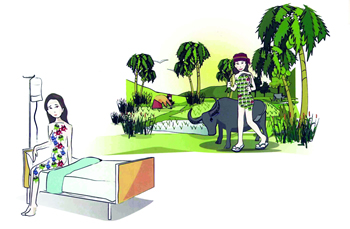Drawing From Life to Explain HIV/AIDS
October 2010—Successful HIV/AIDS prevention, treatment, and care depend on how effectively facts about this immensely complex disease can be communicated. For treatment educators and counselors in Asia, the task can be particularly daunting in low-literacy communities.
Discouraged by the dense explanations and complicated terminology of most treatment literacy materials, TREAT Asia's community program manager, Jennifer Ho, decided a few years ago to try another approach. Visual storytelling, she reasoned, could help make HIV/AIDS treatment less intimidating and confusing. "I thought, why not give treatment educators a tool that is entirely visual?," she remembered.

To explain how HIV attacks the immune system, this illustration, from the HIV
treatment flipchart, shows the healthy body represented as a securely fenced
garden. HIV in the form of a termite has begun to attack the fence, however,
allowing opportunistic infections (pigs and chickens) to invade and destroy
the garden. |
The result is a groundbreaking educational flipchart—widely distributed in China, Cambodia, Indonesia, and Viet Nam—which uses simple, vivid images drawn from everyday life to help explain HIV/AIDS. To describe how HIV attacks the body's immune system, for instance, the chart depicts a garden with a secure fence, which is damaged by termites (HIV), thereby allowing pigs and chickens (opportunistic infections) to invade and destroy the garden.
Saban Prak works with HIV-positive women in Phnom Penh and regularly uses the Cambodian version of the flipchart to explain treatment issues. "As an HIV educator, the most difficult things for our clients are the names of antiretrovirals. They are illiterate so they can't write them down—they have to remember," she said. "The flipchart makes it simpler by using pictures. The pictures also make it easier for us to explain things like the HIV life cycle."
By distilling complicated information about HIV and its treatment into accessible images and situations, the interactive booklet also helps strengthen the connection between treatment educators and their clients. For each illustration in the booklet, educators are offered instructions in their own language for using the image to explain an aspect of HIV—an interactive structure that encourages cross-communication.

| The stages of HIV infection are explained with an image of a woman working in the field and later hospitalized as her health deteriorates. In the picture above, the woman is active and has a strong CD4 count (represented in green) with a relatively low level of HIV (red). Later, when she is hospitalized, her CD4 count is lower (fewer green), her viral load is growing (red),and she has a rising number of opportunistic infections (blue). |
|
Originally developed in a collaboration between TREAT Asia and treatment educators at
AIDS Care China, the booklet's images have been modified and its text translated for each additional country to reflect different cultural contexts. The Chinese edition explains the stages of HIV infection by showing a woman shopping in the market, for instance, while the Cambodian version, which is aimed at rural communities, situates her in the field with a water buffalo.
The HIV treatment flipchart, which was developed through a grant from GlaxoSmithKline/Positive Action, is now considered a key training tool for counselors in each country, and hundreds of copies can be found in clinics and hospitals. In China, where the booklet has been in use since 2005, at least 20 Red Ribbon sites employ it regularly, reaching more than 6,000 patients.
Three hundred copies of the Vietnamese edition, which was revised in 2008 with the help of World Concern Vietnam, are used by counselors and self-support groups at approximately 55 sites around the country. A similar number of sites regularly use the Khmer version, which was revised and distributed in 2009 with the help of the Cambodian Community of Women Living with HIV. And in Indonesia, the PITA Foundation finished revising the Bahasa Indonesia version of the flipchart in 2009 and 50 copies are in use by clinics and counselors around the central Jakarta area.